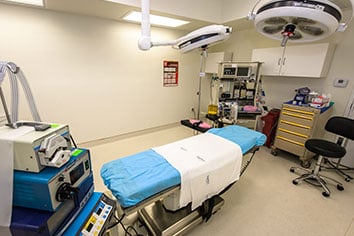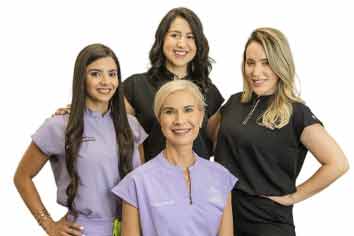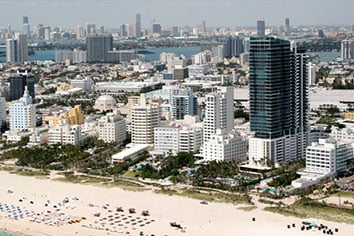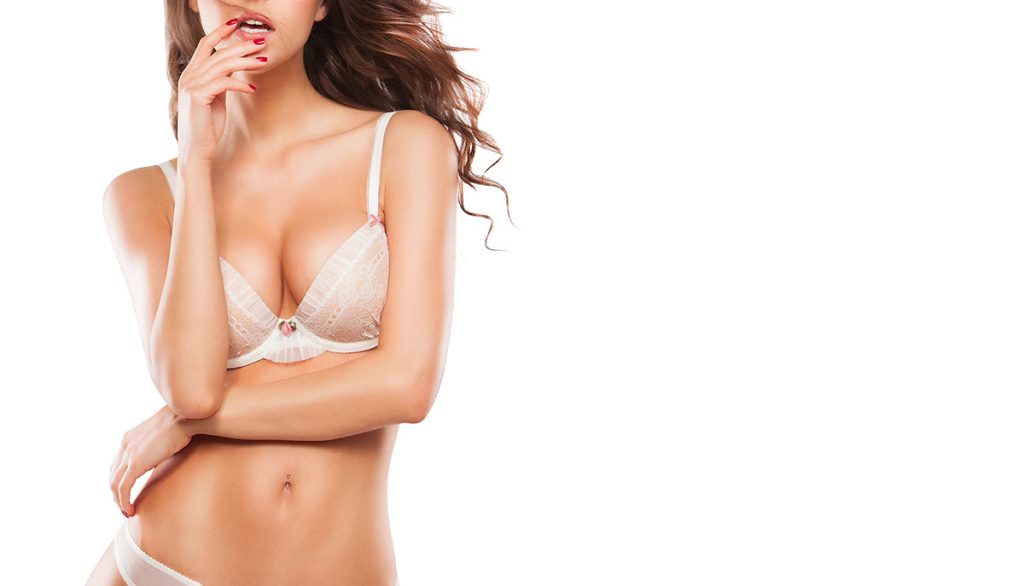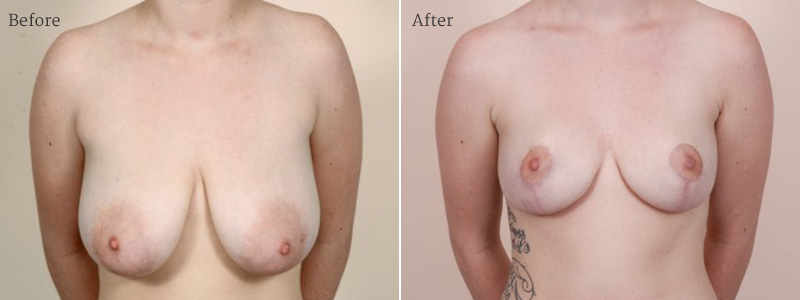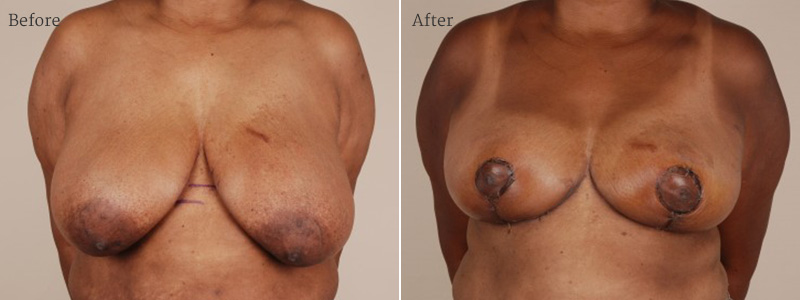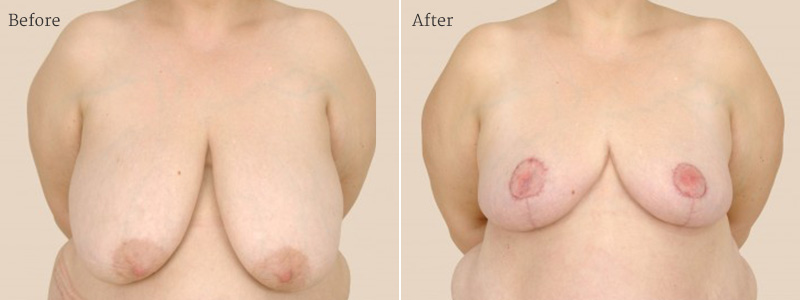In popular media, we often hear about which stars recently got breast implants, but we rarely hear about breast reductions.
In fact, this surgery is one of the most requested and successful plastic surgery procedures. Breast reduction, or reduction mammoplasty, helps women to live active, pain-free lives without symptoms caused by heavy breasts.
Macromastia is the medical term for large breasts, and it can either be symptomatic or asymptomatic. When it is symptomatic, women may have chronic pain in one or more of areas of their body, including the neck, shoulders, back, chest, and even tingling sensations in the hands. Heavy breasts can also result in headaches, bad posture, sleep problems (including sleep apnea), shortness of breath, and scar-like lines in the skin caused by the grooves of a bra-strap. Many women with macromastia may avoid exercise because of the pain they experience during exercise due to the size/weight of their breasts; as a result, these women are at risk for obesity as well.
If you are having the issues previously described, reduction mammoplasty, commonly known as a breast reduction, might be a good choice for you.
What is a Reduction mammaplasty

According to recent statistics by the Amercian Society of Plastic Surgeons, nearly 90,000 patients underwent breast reduction surgery in 2009 alone. Reduction mammaplasty is a cosmetic surgery that reduces the size of the breasts, and in turn, decreases symptoms of pain. In particular, the procedure removes excess breast fat, glandular tissue, and aligns the breast in size with proportion of the rest of your body. A breast reduction most often can be conducted as an outpatient procedure and does not require an overnight hospital stay. The recovery is a few weeks, and scars tend to heal well.
As a top Miami plastic surgeon, Dr. Silvia Rotemberg, who is known for her personalized care, will perform a complete consultation, including an exam to determine your overall health, discuss your concerns, and determine if undergoing a breast reduction is the right choice for you.
Candidates
- Heavy breasts that limit exercise or movement and/or cause pain
- Polycystic mastitis, which are breast infections that results from cystic breasts
- Sufferers of back, neck, shoulder, or breast pain due to the size of their breasts
- Patients who experience numbness or tingling in their breasts, arms, or fingers due to their heavy breasts
- Patients who have sleep disturbances or poor posture resulting from heavy breasts
- Patients with grooves in their back from their bra-straps
- Patients with scarlike lines on their breasts
Types
Pedicle Method
The most common type of breast reduction surgery is called the pedicle method. This method has the benefits of maintaining function and sensation of the nipples and breast, while reducing the contour, volume, and size of the breasts themselves. There are two kinds of pedicle methods: the inferior pedicle method and the superior pedicle method.
Inferior Pedicle Method
In this method, the lower part of the breast is repositioned, yet the nipple and areola connected to the tissue are kept in place. As a result, blood supply is maintained, and the nerves in the breast remain connected. This method is one of the lowest in the risk of losing sensation in the nipples, and also may allow women the ability to still breastfeed after full recovery from surgery.
Superior Pedicle Method
In this method, the nipple/areola remain attached to the tissue in the upper part of the breast, thereby maintaining blood supply and nerve connectivity. This method helps remove the lower hanging tissue of the bottom half of the breast, and may produce a desired projection of the breast, or “perkiness.” Like the inferior pedicle method, this method also has a low risk for sensation loss in the breast and may allow for breastfeeding after full healing from surgery.
Free Nipple Graft
This method of breast reduction surgery requires removing the nipple from the breast itself and then returning back to the breast through a skin graft. No pedicle is involved in this procedure because no blood supply is used from the breast. Instead, the blood supply for the free nipple graft is taken from the deep dermis, also known as the second layer of skin. Because complications may result from this method, it is not as commonly used.
Anchor Incision Pattern
This incision pattern is one of the most common used techniques in breast reduction surgery. Basically, a circular incision is made around the areola in the front of the breast and down to the chest wall. Then the incision is followed through horizontally along the underside fold of the breast to form the shape of an anchor.
LeJour Incision Pattern
The LeJour incision pattern is another popular breast reduction technique, though fairly new. It requires cutting a circular shape around the areola and then cutting vertically into the front of the breast down to the chest wall. Unlike in the anchor incision pattern, the fold of the breast is not cut into horizontally.
Stevens Laser Bra
This newer technique does something dramatically different than all other techniques mentioned. The incision pattern is similar to the anchor incision method; however, a laser bra is affixed to the chest wall internally. This laser bra creates a permanent support system for the patient, rather than just removing excess skin. The laser bra itself is created in a way that the body will not reject it.
What To Expect During The Consultation
Dr. Silvia Rotemberg believes in a collaborative process in which the patient understands all options, and both doctor and patient make decisions for the right course of action. She will then review with you what to expect from the procedure, as well as how to best prepare yourself during the days leading up to and the days and weeks after the surgery.
Prior to the surgery, you may need a mammogram. The doctor will perform a routine breast exam. Several days prior to the surgery, Dr. Silvia Rotemberg will ask you to stop taking aspirin, ibuprofen, warfarin (Coumadin), and any other medications that decrease the ability for blood to clot. Also, Dr. Silvia Rotemberg will make sure you have any prescriptions that you will need after surgery already filled. She will also ensure that you have someone to drive you home from surgery and help you around the house once you return home for the first few days.
On the day of the surgery, the doctor will advise you about eating and drinking, which medications to stop, and also to bring loose clothing that buttons or zips in the front so you do not have to pull it over your head.
Procedure
As described, breast reduction surgery is usually performed via incisions on your breasts followed by removal of excess fat, glandular tissue, and skin. In some cases, excess fat may be removed by the excision techniques in combination with liposuction. If your breast size is mostly due to fatty tissue and excess skin, then sometimes the doctor may elect to only do liposuction. The surgery itself takes two to five hours, sometimes more.
The four steps to the procedure are anesthesia, the incision itself, removing tissue and repositioning, and finally closing the incisions. Depending on your discussion with the doctor, you may undergo intravenous sedation or general anesthesia.
Dr. Silvia Rotemberg’s surgical artistry informs her choice of the ideal technique used for your breast incision so that scarring is minimal and not noticeable. When closing the incision, sutures will be layered deep within the breast tissue. After surgery, the doctor will apply a dressing to protect the areas of incision.
Most patients are sent home the same day after surgery.
Before & After Photos
Recovery
The recovery process for a breast reduction procedure will depend on each patient. The doctor has a specific and detailed recovery plan for each patient, and it should be followed as recommended for optimal results. You will need to take at least one week off from work or school; in fewer cases, some people need a full two weeks of recovery time.
Dr. Silvia Rotemberg’s hands-on approach to recovery is to be available to each patient. She and her qualified staff have a warm and welcoming approach from consultation to recovery. Her office will prioritize your concerns as their own concerns.
Dr. Silvia Rotemberg will instruct you regarding follow-up appointments for removing bandages and sutures. During recovery, you will need to stop exercising for one full month. You should expect to experience some fatigue and have some breast pain. Dr. Silvia Rotemberg will give you an oral painkiller to help you for the first few days after surgery. You will also want to help reduce swelling by using ice packs.
Cost
The costs of breast reduction can vary based on your specific needs. Dr. Silvia Rotemberg’s consultation will provide costs for each procedure.
If you are considering a breast reduction, read you insurance policy. If your insurer has a reduction mammoplasty policy exclusion, you will not get coverage. In some cases, Dr. Silvia Rotemberg may write a letter describing your symptoms and physical findings due the weight of your breasts. You must make an appointment to consult with the doctor about your insurance needs prior to scheduling surgery. In many symptomatic macromastia cases, insurance companies will deem the procedure to be a medical necessity; however, preauthorization is generally not available in Medicare and Medicaid plans.







